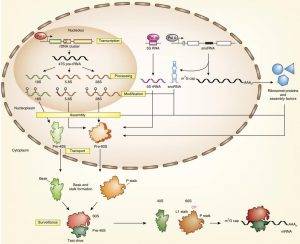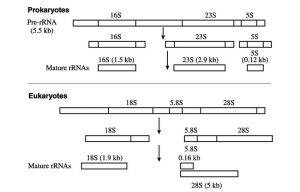What is ribosomal RNA?
Ribosomal RNAs (rRNA) are the major components of ribosomes, which are responsible for protein synthesis by converting the instructions found in messenger RNA into the chains of amino acids. The key catalytic activity of ribosomes comes from the rRNAs. Additionally, rRNAs play an active role in recognizing conserved portions of mRNAs and tRNAs. rRNA molecules are synthesized in the nucleolus, which contains the genes that encode rRNAs. Each ribosome contains at least one large rRNA and at least one small rRNA. The large and small rRNAs combine with proteins to form the subunits of the ribosome, such as the 30S and 50S particles in prokaryotes. These subunits are named according to their rate of sedimentation. In eukaryotes, a single cell may contain 50 to 5,000 sets of rRNA molecules and 10 million ribosomes. In contrast, a prokaryotic cell generally contains fewer sets of rRNA molecules and ribosomes.

Figure 1. Eukaryotic ribosome biogenesis at a glance (Lafontaine et al. 2015.
Types of rRNA
Prokaryotic and eukaryotic ribosomes are made of different types of rRNAs. In prokaryotes, the 30S and 50S subunits join together to form the 70S functioning ribosomes. The 30S subunit contains a 16S rRNA molecule and 21 proteins, while the larger 50S subunit contains two RNA molecules, 23S (nearly 3000 nucleotides) and 5S (about 120 nucleotides), which are accompanied by ribosomal proteins to form the 50S subunit.
The eukaryotic ribosome consists of a 60S and a 40S subunit. There are two short rRNA molecules (5S and 5.8S, less than two hundred nucleotides in length), and two much longer rRNA molecules, 28S (about five kilobases) and 18S (nearly two kilobases). Additionally, both mitochondria and chloroplasts contain rRNA.

Figure 2. Ribosomal RNAs in prokaryotes and eukaryotes (Lafontaine et al. 2015).
Evolutionary implications
The evolutionary implications of rRNA stem from its ability to catalyze the peptidyl transferase reaction during protein synthesis. Thus, rRNA, in serving both as a catalyst and as a repository of nucleic acids, plays a vital role in the early evolution of life on earth.
In bacteria, the 16S rRNA has been proved to be the most informative marker for evolutionary investigations. The 16S rRNA is present in all bacteria and eukaryotes and is of appropriate size for evolutionary studies. Analysis of 16S rRNA has revealed that some portions of the molecule undergo rapid genetic changes, which enables researchers to distinguish different species within the same genus and infer phylogeny.
For fungi, both 18S rRNA and ITS can be used to access fungal diversity and phylogeny. The eukaryotic rRNA cistron consists of 18S, 5.8S, and 28S rRNA molecules, and two internal transcribed spacers will be removed in the posttranscriptional processes. These two spacers and the 5.8S are usually referred to as the ITS region.
16S/18S/ITS amplicon sequencing is a powerful tool for microbial diversity analysis by targeting rRNA. Compared with metagenomic sequencing, it allows for determination of microbial diversity and abundance at a much faster and easier manner.
References:
- Olsen, G. J., Lane, D. J., Giovannoni, S. J., Pace, N. R., & Stahl, D. A. Microbial Ecology and Evolution: A Ribosomal RNA Approach. Annual Review of Microbiology, 1986, (1), 337–365. doi:10.1146/annurev.mi.40.100186.002005.
- Lafontaine D L J. Noncoding RNAs in eukaryotic ribosome biogenesis and function. Nature structural & molecular biology, 2015, 22(1): 11.


 Sample Submission Guidelines
Sample Submission Guidelines